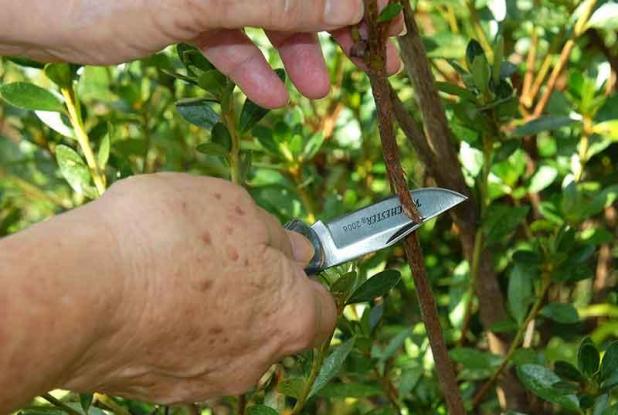
The first step in layering is to use a knife to make a slanting cut on the underside of the stem angled toward the tip of the branch.
—LSU AgCenter/Rick Bogren
Get It Growing: Propagate plants through layering
Plant propagation is fun and provides you with extra plants for your landscape or to share with friends. Plants can be propagated in a variety of ways, such as planting seeds or rooting cuttings, but layering is often overlooked by gardeners who are unfamiliar with the technique. When layering, roots are induced to develop on a stem while it is still attached to the parent plant. Early summer is a great time to start layers because it provides a long growing season for roots to form and grow.
Simple layering and air layering are the two most commonly used techniques. In both procedures, the stem is wounded by cutting or scraping, causing an interruption in the downward movement of sugars and hormones in the stem. These accumulate near the wounded section, and under the right conditions, cause roots to form. Because the stem is still attached to the parent plant, the part to be propagated still receives water during the rooting process, and you can root a much larger piece than with cuttings.
Simple layering is easy to do. This method is excellent to use on woody plants that have low, supple branches, such as azaleas, camellias, spireas and other shrubs. Select the branch to be layered, and bend it so that a spot 12 to 18 inches from the tip of the branch touches the ground. Holding the branch out of the way and using a trowel, dig a shallow hole where the branch touched the ground.
Next, wound the branch at the spot where it touched the ground by using a knife to make a slanting cut on the underside of the stem angled toward the tip of the branch. The cut should be no deeper than about half way through the stem. Or scrape away a ring of bark about three-quarters of an inch wide. Dust the wound with rooting hormone. If you wounded the stem by cutting it, wedge the cut open with a small pebble or twig.
Finally, put the wounded section of the branch into the hole and cover it with 2 or 3 inches of soil. Put a stone or brick on top to hold the branch in place.
Throughout the summer, keep the area around the layer moist. The layer should have rooted by October, so check it then. If roots have formed, cut the rooted branch from the parent plant, making the cut just behind the rooted area of the stem, and plant the rooted cutting in a pot or in the landscape.
Air layering is a variation of simple layering used on plants when a low, supple branch is not available. Air layering can be done with a wide variety of both tropical houseplants and landscape trees and shrubs, such as citrus, ficus, azalea, magnolia, dracaena, schefflera, dieffenbachia, holly, hibiscus and many others.
Start by selecting a branch about one year old. At a point 12 to 18 inches from the tip, wound the stem as described for simple layering. If a slanting cut is made, wedge it open with a match stick, toothpick or a bit of damp sphagnum moss. This will keep the wound from healing over and prevent root formation. Apply a rooting hormone, then cover the wounded area with damp sphagnum moss about the size of a baseball. Wrap the moss with plastic kitchen wrap, making sure no moss is exposed beyond the plastic because it could act as a wick and dry out the moss inside the plastic. Twist each end to make tight seals on the stem above and below the moss. Tie or tape these ends to prevent moisture loss.
If the air layer will receive any direct sunlight, cover the plastic with aluminum foil. This prevents sunlight penetration through the clear plastic that would cause excessive heat buildup and prevent root formation.
The most common mistake made in air layering is allowing the moss to dry out. The moss must remain damp, or rooting will not take place. Occasionally loosen the top of the plastic and check the moss to make sure that it doesn’t dry out. Add water as necessary and reseal the plastic.
Rooting generally takes between eight and 12 weeks. Whenever roots are clearly seen through the plastic, the air layered stem can be cut immediately below the roots. Remove the plastic, but leave the moss attached to the newly developed roots. Plant the cutting in a container of potting soil and place it in a bright location but not in direct sun until roots develop further. Then move it to a permanent location.
When the air layer is cut away, the portion of stem below the cut may be completely leafless, but in a short period of time, dormant buds will generally begin to grow. This works particularly well for indoor plants that have grown too large. By air layering, you reduce the size of the original plant when you cut off the rooted layer, and you also end up with a new plant.
Layering is a simple way of creating new plants, and the success rate is quite good. If you have had difficulty with cuttings, these methods may be the answer to your problems.
